The more I learn about plant taxonomy, the more I learn about plant taxonomy. That may sound simple, but it's true. Generally, my lessons in plant taxonomy consist of learning a new botanical name. I'm slowly building this big dictionary of names that encompasses all of the plants on the planet! The real learning comes in all of the connections that I see - sometimes with my eyes, other times with the names.
I have been fascinated to find plants whose botanical names indicate that they are related, either in the same Genus or by Family, when I cannot
see any resemblances in the related plants. Probably the most obvious example of this scenario is with the genus Euphorbia.
The genus Euphorbia contains more than 2000 unique species of plants, and probably well over 10,000 hybrids and cultivars. Can you believe that!?! I mean, as a little kid, that's probably the number you would guess for how many plants are in the world. But no, that's just how many
species of
Euphorbias there are!
Euphorbias range from very severe cactus-looking plants to more soft and fuzzy herbaceous-looking plants. Some are insular, which means they are endemic to an island. Here's an idea of the contrast of the Euphorbia genus:
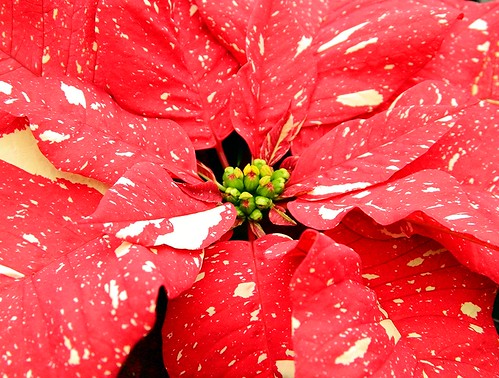 |
| Poinsettia (Euphorbia pulcherrima) - photo courtesy Flickr user Carlin |
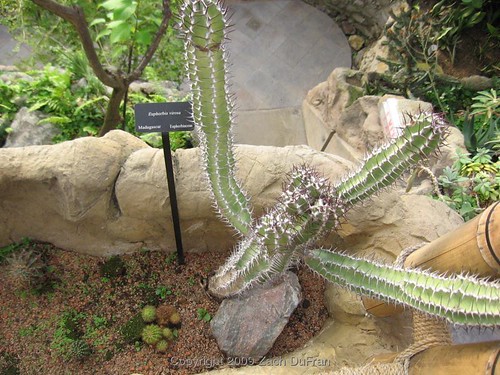 |
| Euphorbia virosa at the OKC Myriad Gardens |
What!?! Those two plants are in the same genus? You might as well tell me that this dainty little plant (below) is also a Euphorbia!
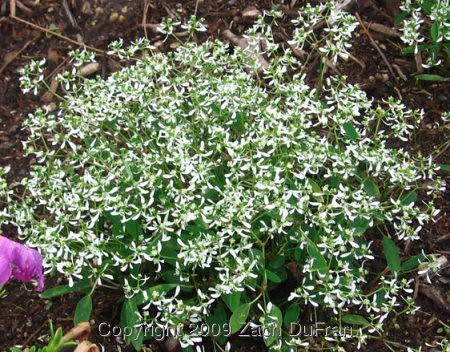 |
Euphorbia 'Diamond Frost' planted at the Fort Worth Botanic Gardens.
This is a new hybrid plant that was introduced in 2007.
|
Oh, it is!
I don't really know what the qualifications are for putting plants in the same genus. The plants are supposed to follow the same family rules as those we use for our own families - they are supposed to claim the same ancestors. [I'm related to my sister and my 1st cousin because of common ancestors - parents and grandparents, respectively.] So, the two plants pictured above are supposed to have descended from the same plant at some point. It would be interesting to study what environmental conditions led to such different species attributes. I'm sure someone has studied that. Euphorbia is a pretty well-known, popular genus.
Currently DNA studies are still pretty costly (time and money) and I don't know how much work has been done on the genus Euphorbia. Another criterion for putting plants into genera is to create reasonable compactness. The word "reasonable" is an ambiguous measure, but I would say that the Euphorbia genus is overly-large in comparison with 95% of other plant genera.
I wouldn't be surprised if a couple years down the road I hear that the Euphorbia genus is going to be ripped into two, three or even 15 pieces. I'm sure all the little children of the world will be in shock, kind of like when Czechoslovakia became two countries or when Pluto was informed that it was no longer a planet.
The one attribute of which I am aware that all Euphorbias have is the milky sap inside the plants. I don't suggest snapping any of your Euphorbias apart to see, but most people have seen the white sap when a Poinsettia leaf breaks off the plant. This sap is supposedly present in all Euphorbias.
Many Euphorbias have very similar inflorescences. They are little bell shapes borne on tall stems, with leaves right up to the blooms. You'll see the similarities in the pictures below.
The Perennial Shrubs
I'm just becoming familiar with the group of Euphorbias that are grown outdoors in the mid-latitudes gardens. They are commonly called Spurges, but usually called by one of their cultivar names, such as 'Chameleon,' 'Tiny Tim,' or 'Blackbird.' I have one of these plants ('Excalibur') planted in my corner garden and pictured lower in this post.
 |
| Euphorbia (dulcis or purpureum) 'Chameleon' - photo courtesty Flickr user Sigrid Frensen |
 |
Euphorbia x martinii 'Rudolph' - photo courtesy Wayside Gardens.
This cultivar is threatening to replace the Poinsettia as the official plant of Christmas.
|
 |
| Euphorbia mellifera (Honey Spurge) - photo courtesy Flickr user pomphorhynchus |
 |
| Euphorbia characias 'Glacier Blue' (Mediterranean Spurge) - photo courtesy Flickr user Liashi |
 |
| Euphorbia characias wulfenii - photo courtesy Flickr user J.G. in S.F. |
These are really neat shrubs because of the color contrast in their foliage. And even though these plants grow in similar conditions in the garden as Azaleas and other tough shrubs, they still have a succulent aspect to them. I don't generally picture succulents stuck in between Irises and Barberry bushes.
 |
| Euphorbia 'Blackbird' - photo courtesy of Flickr user peganum |
 |
| Euphorbia epithymoides (Yellow cushion Spurge) - photo courtesy Flickr user njchow82 |
 |
| Euphorbia continifolia 'Atropurpurea' (Caribbean Copper plant) - photo courtesy Flickr user Sh@ist@ |
 |
| Euphorbia 'Helena's Blush' - photo courtesy Flickr user mediagrrl |
 |
| Euphorbia 'Tiny Tim' - photo courtesy Blue Stone Perennials |
The Succulents
I don't know for sure, but I would guess that the majority of Euphorbias are considered succulents. Many of these have the characteristic spikiness that we generally call a "cactus" and have only small leaves that quickly fall away. The stems themselves do the photosynthesis, in these cases.
 |
| Euphorbia aeruginosa - photo courtesy Flickr user dadoobe |
 |
| Euphorbia columnaris - photo courtesy Flickr user asac_cactus |
 |
| Euphorbia abdelkuri - photo courtesy Flickr user sftrajan |
 |
| Euphorbia greenwayi - photo courtesy Flickr user poppy2323 |
There is an interesting distinction between Euphorbias and Cacti, though. Cacti are from the Western Hemisphere and Euphorbias are from the Eastern Hemisphere. I haven't determined whether the names are applied due to their location of origin, or if they are actually different, as well as being from different sources.
 |
| Euphorbia obsesa - photo courtesy Flickr user sqecial |
 |
| Euphorbia 'Sticks on Fire' - photo from Flickr user markbtall |
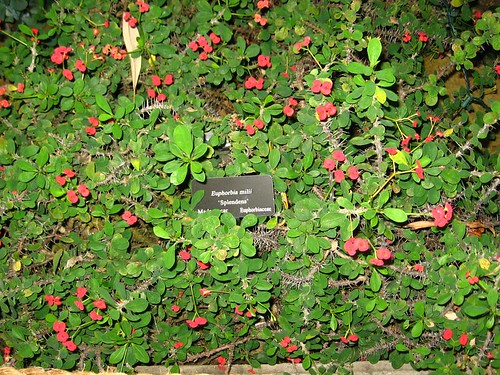 |
Crown of Thorns (Euphorbia milii) in bloom at the OKC Myriad Gardens.
This is one of the few Euphorbia succulents which keeps it's leaves for extended periods of time.
|
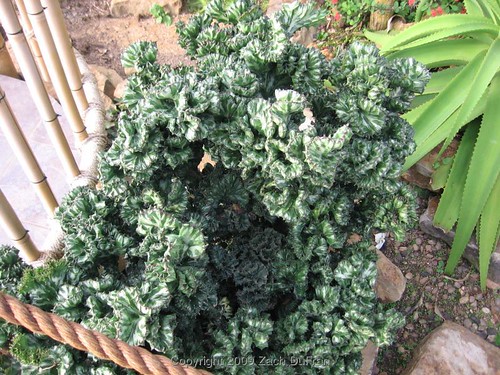 |
| Euphorbia lactea at the OKC Myriad Gardens |
I have to admit that I am not a big fan of cacti-looking plants, but some of these would be hard to pass by if I saw one for sale. I am a big fan of E. greenwayi and E. aeruginosa. It looks like I'll need to invest in a really good pair of gloves before I get either of those, though.
My own collection
I'm not sure that "collection" is the best word to use when describing my Euphorbia plants, seeing that I don't have very many. I think the word "collection" could be applied to my dream set of Euphorbias, though. The more plants I see from this genus, the more I want to try growing.
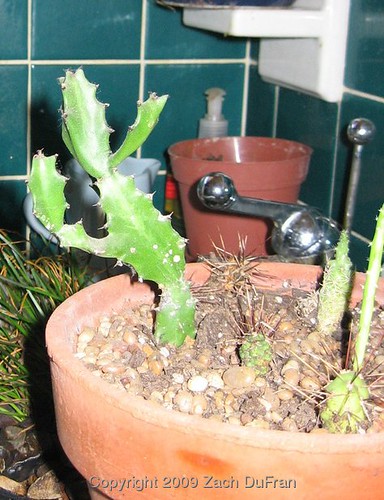 |
| Euphorbia lactea in my "cactus garden" |
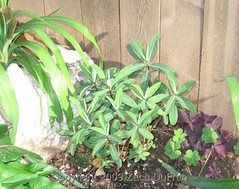 |
Euphorbia longifolia 'Excalibur' planted in my corner garden.
This is what it looked like before Pippa decided to step on it.
|
I bought a Caribbean Copper plant (Euphorbia cotinifolia pictured earlier in the "Perennial Shrubs" section of this post) at the Bustani Plant Farm earlier this summer. I had planned to put this plant in a pot with my Euphorbia 'Diamond Frost' for contrasting foliage size and color, but the plant I bought is a little more leggy than I had expected. For now I have the plant growing solo in a pot. Maybe with a little pruning I can encourage a more dense growth habit.
I have a couple of 'Diamond Frost' Euphorbias (pictured at the top of this post) planted in pots around our house. They are one of the coolest container plants I have seen!
On Monday I posted about some
new plants I received recently, including a variegated Pedilanthus tithymaloides, which is in the same family as the Euphorbia genus (Euphorbiaceae) and has the synonym of Euphorbia tithymaloides.
Of course, I also have a couple of Poinsettias, such as the white one pictured at the top of this post.
Others
There are tons of different Euphorbias, including some that grow into trees. I have seen the Jamaican Poinsettia Tree in bloom at the OKC Myriad Gardens and it was pretty spectacular.
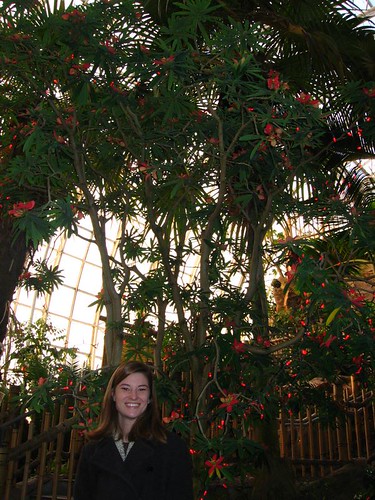 |
| My wife, Christie, in front of the Jamaican Poinsettia Tree (Euphorbia punicea) at the OKC Myriad Gardens |
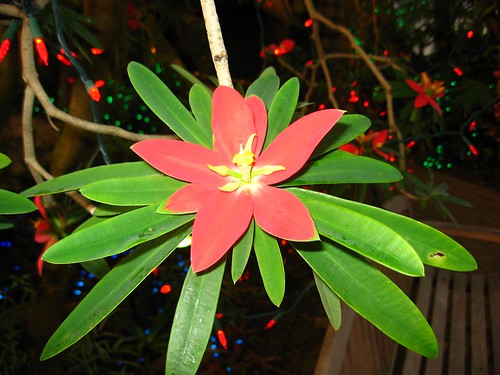 |
| Jamaican Poinsettia Tree bloom (Euphorbia punicea) at the OKC Myriad Gardens |
What Euphorbias have you grown?










This is a large family / genus that has long been divided into sub-tribes. There is a good short discussion on Wikipedia and some useful refs here:
ReplyDeletehttp://www.bioone.org/doi/abs/10.1600/036364404772974266
and
http://waynesword.palomar.edu/trmar98b.htm
I grow the Diamond Frost, and Crowns of Thorns. Euphorbias has so many different types of plants like the Peperomias, they are tropicals, succulents and tender perennials. How they conclude them to be in the same family is a bit confusing. Great post, I really like a lot of the perennial types of the euphorbias. One thing I have noticed about euphorbias they all seem to have milky saps.
ReplyDeleteAh, euphorbias... Some of my favorite plants are in this genus, along with some of the more noxious weeds and obnoxious plants in my garden. I have E. greenwayi and E. cotinifolia and Diamond Frost and a few others that I like, and then there's the pencil tree (E. Euphorbia tirucalli) that I've been trying to kill off for the last 2+ years. (But it looked so cute in the pot...) And then there are the terribly invasive spotted spurge and leafy spurge that are impossible to get rid of in the garden. I guess that if you get a genus large enough, you'll get all sorts of family dynamics going on in it...
ReplyDeleteLoved seeing your website. It IS rather shocking that so many different plants are in the genus Euphorbia. Considering the FAMILY of euphorbs, there is another genus, Jatropha, which is quite interesting--and the sap is CLEAR and somewhat viscous. So there is at least one genus with non-milky sap in the euphorbs group. Plus there are euphorbs in
ReplyDeletethe Americas, too. Euphorbia xantii comes from Baja California--it is a drought-resistant tall greyish green shrub which flowers profusely with small white scented flowers with red buds.
Joanne Gram, Desert Garden Docent at the Huntington Botanical Gardens, California
euphorbia characias wulfeniiMy husband got a drop of the white sap in his eye today. It is like getting acid in your eye. Some websites say it can cause blindness. I never knew how toxic this sap is. Everyone should be informed of this danger. Also toxic if swallowed and irriatating to the skin.
ReplyDelete